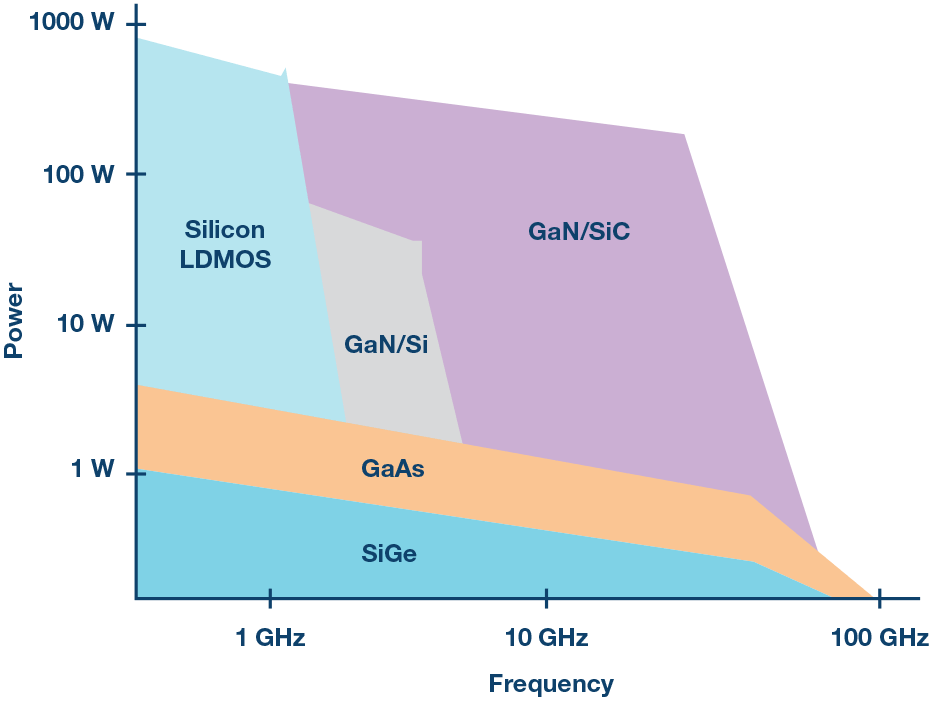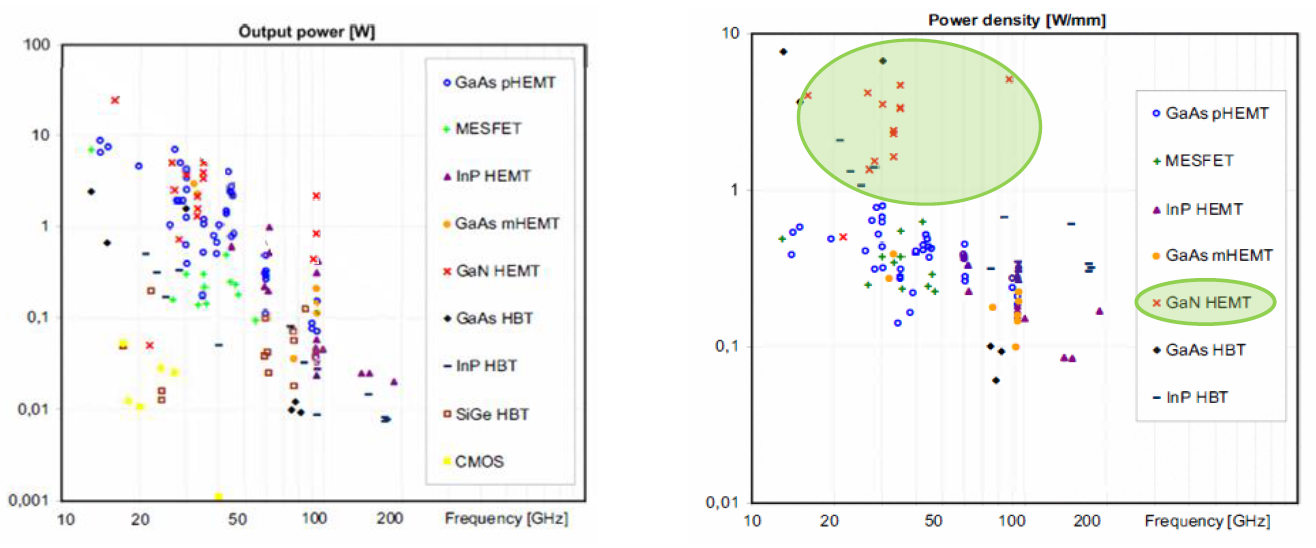 |
6.1GaN HEMT technology |
 |
GaN compound semiconductor devices are now used widely. They have been first used in optoelectronic in blue LED and Blue laser. These materials are now utilised in HEMT for microwave and also in power electronic for DC-DC power conversion.
Indeed GaN technologies have demonstrated exceptional microwave output power performances versus frequency factor of merit with proven reliability for processes mainly below 18 GHz and they are already available on the commercial market. These performances are mostly relying on high breakdown electric field (x10 compared to Si) and electron drift velocity. Fig. 6.2 shows process technology comparison of major semiconductor material used for microwave application as a function of frequency and GaN clearly surpasses all of them.

Fig. 6.2: A process technology comparison of microwave frequency range power electronics.(1)
Fig. 6.3 shows the state-of-the-art of GaN MMIC amplifier output powers and output densities versus frequency. Highest reported results are reaching 15W in Ku band (14 GHz), 8W in Ka-Band (30 GHz) and 2W in E-Band (90 GHz). For the GaN technology, the reader has to be aware that the published results are generally reported in scientific journals and conferences and one has to be cautious regarding the actual performance in to-be-announced commercial products. Main companies addressing this segment are US (Wolfspeed (ex-Cree), Qorvo (merge of RFMD and Triquint), MACOM), Japanese (Sumitomo Elec., Fujitsu, Mitsubishi) or European (UMS, OMMIC). Except 2 (MACOM & OMMIC claiming to use also Si substrate), all companies have been developing GaN on SiC substrates for thermal dissipation considerations – SiC has a thermal conductivity of 450 Wm-1 K-1, i.e. similar to copper at room temperature, i.e. 3 time better than Si. Best GaN results are all today obtained using SiC substrates.
It is important to recall to the reader that microwave power and power electronic are quite different in terms of power dissipation. Microwave devices are dissipating a lot due to CW operation with efficiencies degrading as the frequency rise. In case of power electronic dissipation exists only during the switching period and efficiency may reach 99% in pulse compared to below 50% at CW 30GHz.

Fig. 6.3: State-of-the-art of GaN MMIC amplifier (for GaN: scientific publication – not commercial specifications), a) Saturated output power in frequency for PA MMIC, b) Power density in frequency for PA MMIC
0.5μm and 0.25μm GaN/SiC HEMT technologies are mature at UMS and now qualified. These device families can be used for frequencies up to 18GHz. This upper frequency is therefore too short for coming telecom markets (c.f. Figure 4). Developments are currently underway at UMS with the support of III-V Lab and IAF to give rise to devices compatible with circuits working up to 35GHz, or even 45GHz using 0.1μm-0.15μm gate lengths. UMS is capitalizing on his former GaN/SiC technologies and their new coming 0.15μm will benefit from their expertise. There is however a large effort to be put before reaching product level. Indeed such development will face challenge like short channel effect, parasitic capacitance, transconductance maximisation, dispersive effect (lag), device topology optimisation, etc. This approach will be the main path to reach state of the art 5G circuits up to 35 GHz. It will benefit from available models to be upgraded to shorter gate length and higher frequency. PDK will have to be derived for active devices and passive elements. The second path will be managed by IAF and III-V Lab who has as objective to push GaN technologies to address the demonstrators planned for higher frequencies above 35 GHz. Swegan will be a major supplier of GaN/SiC epiwafers to UMS. Their demonstration of reduced dispersive effects could be an important advantage to deal with expected high linearity 5G requirements.
_______________________________________________________
(1) Keith Benson: GaN Breaks Barriers—RF Power Amplifiers Go Wide and High, in Analog Dialogue 51-09, September 2017, ![]()